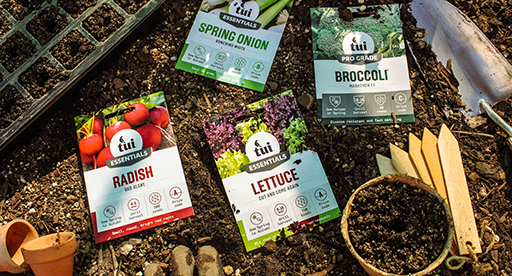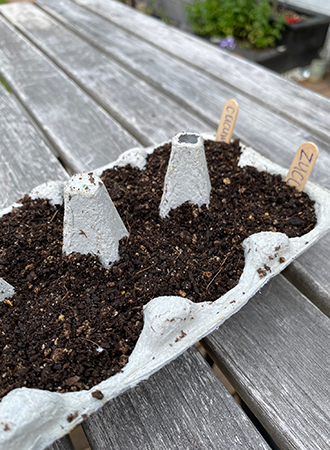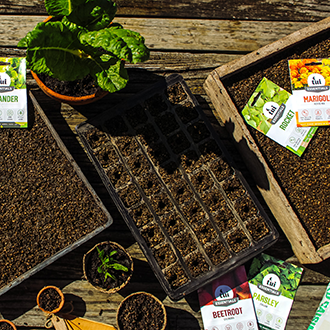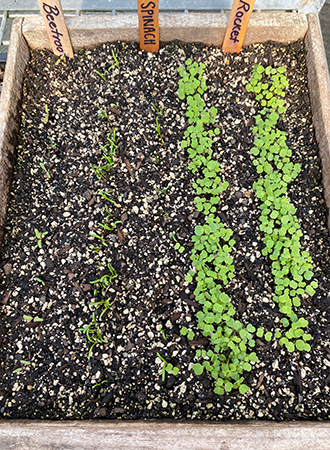
Growing plants from seed is one of the most rewarding experiences for any gardener! It’s exciting to see a tiny seed turn into a lush garden or a burst of colourful blooms.
Whether you’re using seed trays, directly sowing in your garden, or opting for containers and pots, this beginner’s guide will help you nurture your plant from a tiny seed to a delicious crop of veges, or a stunning floral display.

Seed sowing essentials
Seed raising mix A light, well-draining seed raising mix, such as Tui Seed Raising Mix, is key to success. This blend creates perfect conditions for seeds to germinate and seedlings to thrive. You can use this mix whether you're planting seeds directly in the garden, in containers, or in seed-raising trays.
Something to grow in Choose trays or pots with drainage holes to prevent waterlogging. You can also use recycled containers, just make sure they have good drainage. Get crafty and use egg trays or toilet rolls that you may have around the house!
Seeds! Pick your seeds based on your tastes and what you and your family like to grow and eat. Check out Tui Seeds and choose from family vege faves, must-have salad ingredients and vibrant blooms to bring in the bees.
Labels Keep track of what you’ve sown by labeling your trays or pots. They can all look pretty similar to the beginner's-eye so they'll help you remember which plants are which as they grow.
Watering can or sprayer A gentle watering can or a spray bottle helps to moisten the soil without disturbing the seeds. You can get little screw on caps for water bottles that act like a tiny, gentle watering can!

Sowing your seeds
Prepare the soil Fill trays or pots with seed raising mix, levelling it off and gently firming it down. If you're sowing direct to the garden add a 5cm layer of seed raising mix to the soil.
Sowing seeds Some seeds are best sown directly into the garden, like peas, beans, coriander and carrots; whereas other seeds are best sown in seed raising trays. For tiny seeds, lightly scatter them on the surface of the seed raising mix. For larger seeds, create small holes or grooves with a pencil, drop the seeds in, and cover them lightly with compost. Always check the back of the seed packet for individual instructions!
Watering Moisten the soil before sowing, then gently water the seeds after planting. Keep the soil consistently moist but not waterlogged.
Temperature and light Place the trays in a warm place to germinate. Seeds need warmth to germinate, then light once they've popped up, so you can even germinate in a hot water cupboard then bring them out into the light once the seedlings emerge. Most seeds germinate best in temperatures between 18-24°C.

Caring for your seedlings
Monitor moisture Check regularly to make sure the soil remains moist. Be careful not to overwater; the soil should be damp, not soggy.
Ventilation If using a cover, make sure there is ventilation in the lid, lift it occasionally to allow fresh air to circulate and prevent fungal diseases.
Thin your seedlings Once seedlings have grown a bit, thin them out if they’re too over-crowded to give each plant enough space.
Pot up your seedlings When they have two true leaves transplant the seedlings into a slightly bigger pot, about the size of a yogurt pottle, filled with a quality potting mix or vegetable mix. This will give them space to grow bigger before you harden them off and plant in the garden. Using an ice cream stick, little fork or teaspoon can be handy when transplanting to avoid disturbing the roots.
Transplanting to the garden
Hardening off Gradually get seedlings used to outdoor conditions by placing them outside for a few hours each day, increasing the time over a week or two.
Timing Transplant seedlings when they are about the size you buy in the garden centre, and there is no risk of frost.
Soil prep Ensure the garden bed or container is well-prepared and free of weeds. Dig in compost and sheep pellets to enrich the soil and give your plants the best start.
Post a comment
Beginner's guide to growing from seed Comments
I line my seed trays with newspaper before adding seed growing mix. This helps to keep the mix damp, without drying out. My seeds seem to thrive at this initial stage of growing.
Jane Utting
Thank you for all the helpful tips much appreciated.
Richard Paul